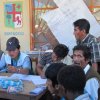Mian Issa, Phase I
Mian Isa is the largest village in the Mughalki Union Council in the Nowshera District. According to the 1998 census the population of the district was 874,373; the annual growth rate was 2.9% and the proportion of urban dwellers was 26%. The literacy rate, which is 89%, is comparatively good.
Located in the west of Pakistan’s most sensitive province the KP province, Nowshera’s characteristics resemble that of a typical fragile state: weak governmental structures, weak internal cohesion and a high degree of inequality, with massive challenges arising from extreme poverty, armed conflict and instability. In addition, the area’s fragility can be explained in terms of natural disasters; its location in a natural hazard-prone area exposes it to floods twice a year, river erosions, earthquakes, avalanches, and land- and mudslides.
The objective is to contribute to the development of disaster resilient communities in the Nowshera district through community based disaster risk reduction (CBDRR). The community in of Mian Isa village gains the capacity to manage disaster risk and enhances local capacity to plan and implement CBDRR programmes in the Nowshera district. Main activity is establishment of community disaster management committees and training. Each community / committee develops and implements contingency plans. On an institutional level the projects facilitates cooperation among strategic actors and established a CBDRR network from community to district level which seeks to influence the Nowshera district’s development planning.
The project follows a community-driven development effort to reduce vulnerability and promote disaster resilient communities in the Mian Isa village. In the strategy the partners acknowledge the need for a development effort that takes proper account of the necessity to protect the beneficiaries and their livelihoods from hazards in line with the five priorities established in the Hyogo Framework for Action
- Ensure that disaster risk reduction is a national and a local priority with a strong institutional basis for implementation.
- Identify, assess and monitor disaster risks and enhance early warning.
- Use knowledge, innovation and education to build a culture of safety and resilience at all levels.
- Reduce the underlying risk factors.
- Strengthen disaster preparedness for effective response at all levels.
By focusing on a community-based approach to DRR primarily through participation, empowerment and organizational capacity building, the project improves the beneficiaries’ ability to ‘self help’. Mobilization of the communities to identify problems, and plan and manage their own development helps strengthen local capacity for collective action towards disaster resilient communities and strengthening of state-community synergies.
The project contributes to sustainable cities and communities in compliance with the current UN Sustainable Development Goals.
Specifications
- Project No.: 023
- Categories: Disaster Relief, Building and Construction, Asia, Pakistan
- Budget: 674.246 DKK
- Project Manager: Peder Eliassen
- Partner Organization: Karwan Development Foundation (KDF)





 2.jpg)


